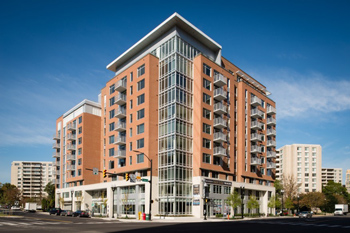KKR Real Estate Finance Trust Inc. (NYSE: KREF) has assembled a loan portfolio during the past few years that is matched to a conservative set of liabilities—a strategy that has held up well during recent market volatility fueled by the COVID-19 pandemic.
Externally managed by an affiliate of global investment firm KKR & Co. Inc., the mREIT was created to take advantage of the opportunities KKR saw in its private equity real estate funds.
Matt Salem, CEO of KREF and partner and head of KKR’s real estate credit business, notes that “KKR’s view was that real estate credit offered attractive risk-reward returns and the best way to take advantage of that value was to build out an integrated credit team alongside KKR’s real estate equity business.”
KKR chose a publicly traded mREIT format because it would provide the most cost-effective access to capital, as well as the opportunity to scale the portfolio over time as the client base grew, Salem adds.
Salem notes KREF’s affiliation with KKR has been its strongest differentiator as it provides the firm with a unique perspective and a look into risk-adjusted returns across asset classes.
“KKR’s integrated real estate equity and credit model gives us sourcing and underwriting advantages,” Salem says.
Best in Class
On the liability side, KKR leverages its 45-year history and deep relationships to create best-in- class liabilities for KREF. This durable capital structure was stress-tested in the early stages of the pandemic and held up well.
“We have combined these advantages with a conservative and disciplined management approach to asset selection,” Salem says. “We match our loan portfolio with one of the most conservative and diverse set of liabilities, which again has allowed us to differentiate ourselves during this volatile market.”
From the outset, KREF’s primary strategy has been to originate senior loans secured by transitional properties located in major markets, owned by best-in-class sponsors.
“We leverage the expertise and perspective of KKR’s broader asset management platform— including its fully integrated real estate equity investing team—to source and underwrite, which we believe positions us to create differentiated outcomes for our investors,” Salem says.
Since its IPO in 2017, the mREIT has shifted its portfolio to a more conservative posture, reflecting a view that the real estate and economic cycles were in the later stages. This can be seen in its heightened focus on institutional quality real estate and sponsorship, which led to an increase in average loan size from $50 million when KREF started to $118 million as of the fourth quarter of 2020. The mREIT has also increased exposure to less volatile property types.
Jade Rahmani, managing director of commercial real estate finance with Keefe, Bruyette & Woods, has followed KREF since it went public and says he is impressed with the mREIT’s asset mix that is concentrated in “resilient sectors.”
“The company is in a healthy position,” Rahmani says. “What KREF is doing well is lending money to value-add investors who are improving the projects. The average commercial real estate loan is 10 years, but for them, the average is around two to three years, and has been undergoing a capital expenditure improvement plan.”
Therefore, even though the buildings may not be fully leased, they are benefiting from recent renovation activity. The geography and property type mix, as well as the duration of their loans, all stand to benefit KREF, Rahmani says.
Purpose-built Portfolio
KREF’s portfolio has performed well through the pandemic as it continues to focus on the institutional sector of the lending market, and continuously re-evaluates the real estate landscape and the impacts of COVID-19 both to protect its capital and to find opportunities.
“Historically, we have been very conservative from a property-type perspective with over half our portfolio secured by multifamily properties,” Salem says. “While I expect multifamily to continue to be our largest exposure, I’m hopeful we will see opportunities to lend on more cyclical property types—such as hotels—at a reset basis as the year progresses.”
An advantage of KREF’s current investment portfolio is that it was purpose-built for the latter stages of an economic cycle.
“As of the fourth quarter, our $5 billion portfolio, which is comprised almost exclusively of senior loans, focused on institutional real estate and sponsorship and is secured predominantly by class-A lighter transitional, multifamily, and office properties located in liquid real estate markets,” Salem says. “Our average loan size is $118 million and nearly 90% of our loans are located in the top 20 markets in the U.S.”
When evaluating a new loan, sponsorship is a key focus for the mREIT, with Salem explaining that it looks to ensure it is lending to the highest quality owners and operators that have the experience and financial wherewithal to implement their business plan regardless of the economic cycle.
As of the fourth quarter, KREF’s investment portfolio was 98.5% first mortgage senior loans with no direct holdings of securities, Salem says. “Our two largest property type exposures are multifamily and office, which together account for 81% of the portfolio. Importantly we have very little exposure to more volatile property types like hotel and retail, which combined represent only 9% of the portfolio.”
Opportunities Ahead
Looking ahead, KREF is working on a couple of industrial construction and life science financings, which will increase its exposure to asset types with strong secular tailwinds.
“In many cases, KREF’s sponsors use our financing to build, upgrade, reposition, and lease properties to meet today’s demands,” Salem says. “I expect there will be demand for capital which can facilitate the creation of new space either through repositioning or construction into sought after sectors such as industrial or life sciences.”
In addition, COVID-19 has negatively impacted many properties, Salem adds, “so sponsors need more time to implement their business plan and we can provide that bridge.”
Salem says KREF is continuing to build momentum with its “solutions-oriented approach,” which has led to increasing business with repeat borrowers. “Through our team’s relationships and KKR’s culture of ‘like and trust,’ we have built a franchise with the highest quality institutional owners and operators.”
“KREF remains well positioned for the year ahead supported by a conservative portfolio and robust pipeline,” he says.

